Tiliqua gigas

Conservation Status:
Least Concern
Range:
New Guinea and surrounding islands.
Habitat:
Variety of habitats, including forests, scrubland, and urban environments.
These relatively large, arboreal lizards inhabit rainforests and tropical woodlands, shrubland, and even urban environments. They can eat a variety of foods including snails, bugs, and plant material. Their flexibility in habitat and diet has made them adaptable to human encroachment and they remain classified as Least Concern on the IUCN Red List. While they have not been extensively studied for conservation, their habitat faces threats such as deforestation and potential collection for the pet trade.
One of the most remarkable features of Halmahera Blue-tongued Skinks is their vivid blue tongue, which they display when threatened.
They are well adapted for an arboreal lifestyle with prehensile tails for climbing and balance. They are also ovoviviparous, laying eggs that hatch internally, then giving birth to live young.
